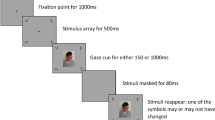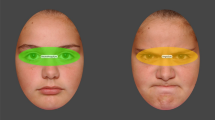Abstract
Social information processing theory hypothesizes that aggressive children pay more attention to cues of hostility and threat in others’ behavior, consequently leading to over-interpretation of others’ behavior as hostile. While there is abundant evidence of aggressive children demonstrating hostile attribution biases, less well documented is whether such biases stem from over-attendance and hypersensitivity to hostile cues in social situations. Over-attendance to hostile cues would be typified by deviations at any stage of the multi-stage process of social information processing models. While deviations at later stages in social information processing models are associated with aggressive behavior in children, the initial step of encoding has historically been difficult to empirically measure, being a low level automatic process unsuitable for self-report. We employed eye-tracking methodologies to better understand the visual encoding of such social information. Eye movements of ten 13–18 year-old children referred from clinical and non-clinical populations were recorded in real time while the children viewed scenarios varying between hostile, non-hostile and ambiguous social provocation. In addition, the children completed a brief measure of risk of aggression. Aggressive children did attend more to the social scenarios with hostile cues, in particular attending longest to those hostile scenarios where the actor in the scenario had a congruent emotional response. These findings corroborate social information processing theory and the traditional bottom-up processing hypotheses that aggressive behavior relates to increased attention to hostile cues.




Similar content being viewed by others
References
Snyder TD, Dillow SA. Digest of education statistics 2013 (NCES no. 2015–011). National Center for education statistics working paper. Washington, DC: US Department of Education; 2015.
Hudley C, Britsch B, Wakefield W, Smith T, Demorat M, Cho S. An attribution retraining program to reduce aggression in elementary school students. Psychol Sch. 1998;35:271–82.
Sutherland KS, Wehby JH. Exploring the relationship between increased opportunities to respond to academic requests and the academic and behavioral outcomes of students with EBD. Remedial special education. SAGE Publications. 2001;22:113–21. Available from:http://journals.sagepub.com/doi/abs/10.1177/074193250102200205
Gottfredson DC, Cook PJ, Na C. Schools and prevention. The Oxford handbook of crime prevention. USA: OUP; 2012. p. 269–87.
Tanner-Smith EE, Wilson SJ, Lipsey MW. Risk Factors and Crime. Oxford handbook of criminological theories. Oxford: Oxford University Press; 2013. p. 89–111.
Crick NR, Dodge KA. A review and reformulation of social information-processing mechanisms in Chidrens social adjustment. Psychol Bull. 1994;115:74–101.
Dodge KA. Translational science in action: Hostile attributional style and the development of aggressive behavior problems. Dev Psychopathol. 2006;18:791–814.
Dodge KA, Pettit GS. A biopsychosocial model of the development of chronic conduct problems in adolescence. Dev Psychol. 2003;39:349.
Coy K, Speltz ML, DeKlyen M, Jones K. Social–cognitive processes in preschool boys with and without oppositional defiant disorder. J Abnorm Child Psychol. 2001;29:107–19. https://doi.org/10.1023/A:1005279828676.
Dodge KA, Bates JE, Pettit GS. Mechanisms in the cycle of violence. Science. [internet]. American association for the. Adv Sci. 1990;250:1678–83. Available from: http://www.jstor.org/stable/2878540
Dodge KA, Price JM, Bachorowski J-A, Newman JP. Hostile attributional biases in severely aggressive adolescents. J Abnorm Psychol. 1990;99:385–92.
De Castro BO, Veerman JW, Koops W, Bosch JD, Monshouwer HJ. Hostile attribution of intent and aggressive behavior: a meta-analysis. Child Dev. 2002;73:916–34.
Barzman DH, Ni Y, Griffey M, Patel B, Warren A, Latessa E, et al. A pilot study on developing a standardized and sensitive school violence risk assessment with manual annotation. Psychiatr Q. 2016:1–11. https://doi.org/10.1007/s11126-016-9458-7.
Horsley TA, De Castro BO, Van Der Schoot M. In the eye of the beholder: eye-tracking assessment of social information processing in aggressive behavior. J Abnorm Child Psychol. 2010;38:587–99.
Dodge KA, Murphy RR, Buchsbaum K. The assessment of intention-cue detection skills in children: Implications for developmental psychopathology. Child Dev. 1984:55(1)163–73.
Lemerise EA, Gregory DS, Fredstrom BK. The influence of provocateurs’ emotion displays on the social information processing of children varying in social adjustment and age. J Exp Child Psychol. 2005;90:344–66.
Orobio de Castro B, Merk W, Koops W, Veerman JW, Bosch JD. Emotions in social information processing and their relations with reactive and proactive aggression in referred aggressive boys. J Clin Child Adolesc Psychol. 2005;34:105–16.
Wilkowski BM, Robinson MD, Gordon RD, Troop-Gordon W. Tracking the evil eye: trait anger and selective attention within ambiguously hostile scenes. J Res Pers. 2007;41:650–66.
Cook AE, Myers JL. Processing discourse roles in scripted narratives: the influences of context and world knowledge. J Mem Lang. 2004;50:268–88.
Hyönä J, Lorch Jr. RF, Kaakinen JK. Individual differences in reading to summarize expository text: evidence from eye fixation patterns. J Educ Psychol. 2002;94:44–55.
Lin PI, Da HC, Juan CH, Hossain MM, Erickson CA, Lee YH, et al. Predicting aggressive tendencies by visual attention bias associated with hostile emotions. PLoS One. 2016;11:1–8. https://doi.org/10.1371/journal.pone.0149487.
Acknowledgements
Cincinnati Children’s Hospital Medical Center.
Author information
Authors and Affiliations
Corresponding author
Ethics declarations
Conflict of Interest
All authors declare that they have no conflict of interest.
Ethical Approval
All procedures performed in studies involving human participants were in accordance with the ethical standards of the institutional research committee and with the 1964 Helsinki declaration and its later amendments or comparable ethical standards.
Informed Consent
Informed consent was obtained from all individual participants included in the study.
Rights and permissions
About this article
Cite this article
Laue, C., Griffey, M., Lin, PI. et al. Eye Gaze Patterns Associated with Aggressive Tendencies in Adolescence. Psychiatr Q 89, 747–756 (2018). https://doi.org/10.1007/s11126-018-9573-8
Published:
Issue Date:
DOI: https://doi.org/10.1007/s11126-018-9573-8




